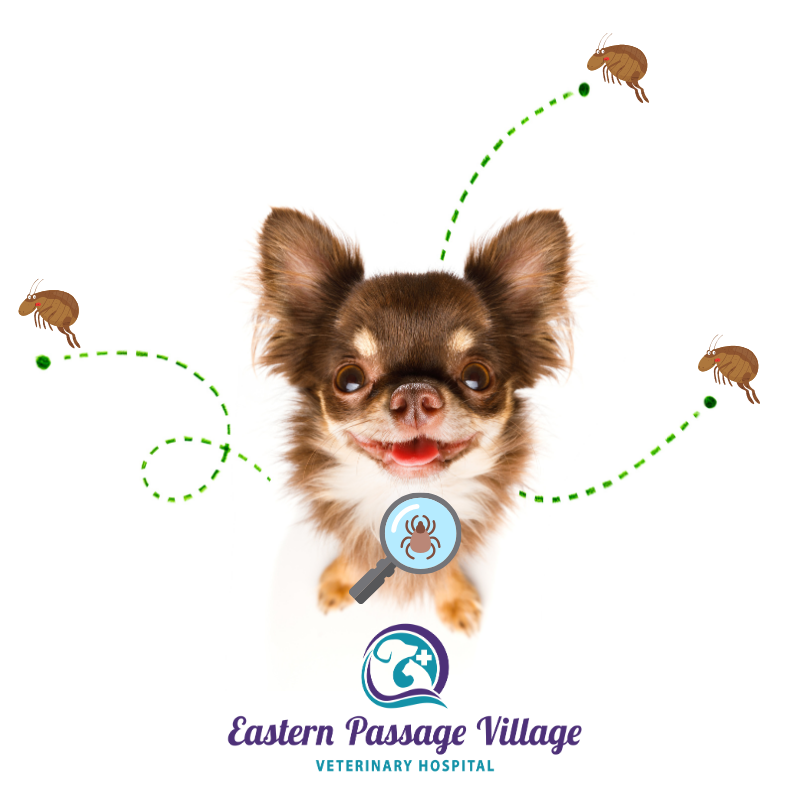By: Dr. Emma Bush, DVM

The most common external parasites of dogs and cats that we see are fleas and ticks. There are both oral and topical preventative products to protect against one or both of these parasites. Most products are given monthly; however, some can last for longer durations. It is recommended to give parasite prevention products year round, particularly with the warmer winters present with climate change, as these parasites are being noted throughout the winter as well as the classically “warmer months”.
It is important to note that products are species specific and are not safe to use interchangeably. Perhaps most notably; Advantix is a canine product that is harmful and can even be fatal to cats – even if just coming into contact with it on a dog. As such, it is very important to be aware of the products that you are giving to your pets as may they impact not only the animal that it was put directly on to.
Fleas
Fleas are known to be the most common external parasite found on dogs and cats. When we picture fleas, we often do so in the hair coats of our pets. However, it is important to note that the majority of the flea population (egg and larval forms) actually live off of the pets and in the surrounding environment like in carpeting, bedding and furniture! Because of this, it is important when treating a flea infestation to treat not just your pet(s) but also your environment through thorough washing and vacuuming of bedding and furniture (make sure to dispose of the vacuum bag) and application of flea-designed sprays to topical regions of the home.
When we think of fleas, we tend to think of itching. This is known as Flea Allergy Dermatitis (FAD) where the pet is allergic to the saliva of the flea and becomes intensely itchy following a flea bite (even from as little as just a single flea bite!) to the point of causing hair loss, rashes or even wounds through scratching. This on its own is serious enough, however, fleas can also spread disease and, in intense infestations, can cause significant blood loss or anemia through feeding on the blood of their hosts. This can lead to severe health crises and even death. Because of this, a flea infestation is never a casual concern. Pets, especially itchy pets, can be good at licking the fleas off of themselves, so just because you do not see fleas does not mean that they are not there. We cannot rely on our senses alone, and as such, regular use of parasite prevention products is key in preventing these concerns from occurring.
Ticks
Similar to fleas, ticks are skin parasites that feed off of the blood of their hosts. However, our main concern with tick bites is neither itchiness or blood loss, but instead the transmission of diseases.
In Nova Scotia, at this time, the main tick-borne diseases of concern are Lyme Disease and Anaplasmosis.
Lyme Disease is an infectious process that occurs following exposure to the infectious agent Borrelia burgdorferi that ticks can transmit to their hosts following a sufficient duration or attachment. Unlike humans, only about 5% of dogs will experience symptoms of this disease. When symptoms of illness do occur, it is usually weeks to months following transmission. Most common symptoms include signs of limping, lameness or stiffness (Lyme related arthritis). However, in more serious cases the kidneys can be affected with something called glomerular disease.
There is a vaccine for Lyme Disease in dogs, however, a good tick prevention product is still recommended year-round. There are many reasons for this, one of the main ones being the other previously mentioned tick-borne disease of concern in the Maritime provinces: Anaplasmosis.
Anaplasmosis can occur in two forms, Granulocytic (which is an infection of white blood cells) and Thrombocytopenic (which is an infection of platelets). There are no vaccines for these infections so the mainstay of protection is using a good, regular tick prevention product.
Treatment for tick borne diseases consists of antibiotic therapy, as well as supportive and symptomatic care, including hospitalization if required for ill patients. Though treatment exists, parasite prevention is the number one tool to utilize to protect against the transmission of and infection with these disease agents.
Tick prevention products either kill ticks or cause them to drop off prior to the amount of time needed to transfer infectious agents. As such, monthly, year-round tick prevention is imperative and the first line of defense in prevention of these infections.
If you find a tick on your dog, you can remove then with fine-tipped tweezers or tick twister. It is recommended to grasp as close to the skin as possible and to pull up with both even and steady pressure as this is the least likely to leave mouth parts behind. Following removal, dispose of the tick by putting it in a sealed bag, flushing it down the toilet, or submitting it for testing. Do NOT crush the tick in your fingers. Following proper disposal, wash your hands well as well as the area of attachment on your pet. Tick attachment sites will commonly become inflamed and can even become infected. If your pet has been bitten by a tick and you have concerns, please contact your veterinarian.
Stay tuned for a discussion of internal parasites in our next blog post.
